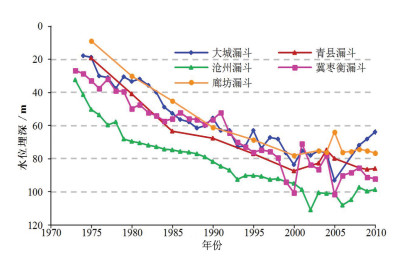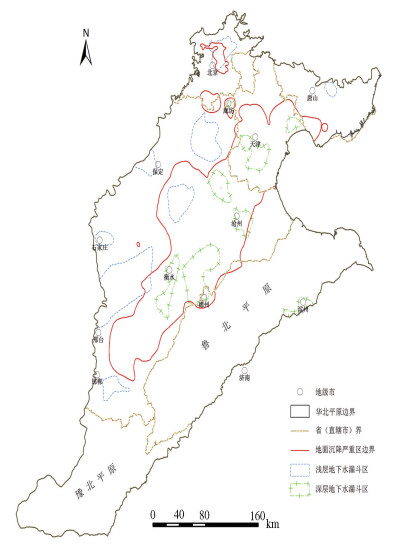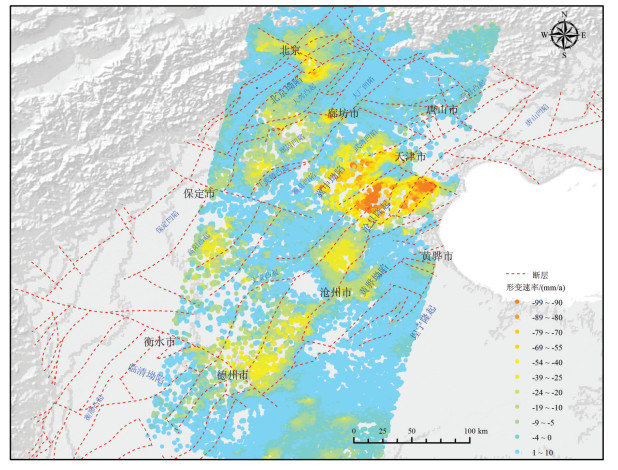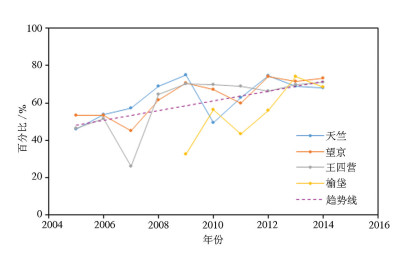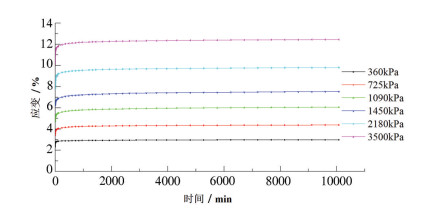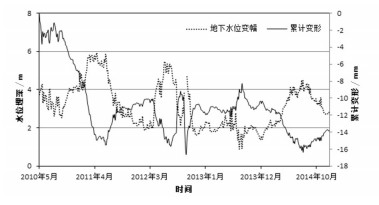The evolution characteristics and mechanism of the land subsidence in typical areas of the North China Plain
-
摘要:
华北平原是世界上最大的地下水系统之一,地面沉降问题突出。由于沉积环境变化多样、地质条件差异性显著和人类开采活动强烈,使得该地区地面沉降成因机理复杂。本文采用卫星对地观测技术与传统手段相结合,监测地面沉降灾变过程,分析华北平原地面沉降发展历史和现状。结合应力-应变图解法及土工实验研究地面沉降差异性特征及滞后变形成因机理。取得了以下关键认识:(1)华北平原地面沉降空间分布差异性明显,沉降主要分布在平原区第四纪沉积凹陷,呈现东西分带、南北分段特点。地面沉降空间发展部分受到北东向和北西向构造控制。在沧县隆起区,地面沉降也比较发育,主要原因是沧县隆起在第四纪时期构造运动相对不活跃,沉积了较厚的第四系;存在与构造走向一致的3期古河道,该地区赋存丰富的地下水资源并被大量开采。(2)地面沉降发生发展与地下水开采历史密切相关,沉降主要压缩贡献层随地下水开采层位变化而变化。北京平原100 m以深地层对地面沉降贡献呈增加趋势。天津平原目前地面沉降的主要贡献层来自300 m以下地层。(3)气候干旱导致地下水补给量减少,同时增加了地下水的开采,因而是引起地面沉降的重要间接驱动因素。高层建筑荷载、基坑降排水、地热开采对地面沉降的影响应引起足够重视。(4)地面沉降具有很强的滞后性,最大滞后时间可达25年。除了渗透固结成因以外,土体蠕变是另外一个重要原因。更新世地层在不同荷载下,蠕变特征明显。沧县隆起晚更新世地层次固结可达到总变形28.3%。(5)土的物理性质、地下水位变化模式对土层变形特征具有重要影响。不同埋深地层在地下水位变化条件下的变形特征存在较大的差异(弹性、黏弹性、黏弹塑性)。浅部含水组呈现以弹性为主的变形特征。
Abstract:The North China Plain (NCP) is one of the biggest groundwater systems in the world, and land subsidence occurs commonly. Due to diverse sedimentary environments, different geological conditions, and intensive groundwater exploitation, the mechanism of land subsidence is complex. With the help of earth observing technique and traditional monitoring tools, the disaster process of land subsidence was monitored, and the developing history and current situation were analyzed. Combined with strainstress diagrams and soil mechanics tests, the difference features of land subsidence and the mechanism of hysteretic deformation were analyzed. Some conclusions have been reached:(1) The spatial distribution of land subsidence is significantly distinct. The land subsidence areas are mainly located in the areas of the Quaternary sedimentary depressions, having characteristics of west-east sub-zone and north-south subsection. The spatial development of land subsidence is partially controlled by NE-and NW-trending structures. The land subsidence in the Cangxian uplift is serious in that the tectogenesis is relatively inactive in Quaternary and the loose sediments are very thick. Also, there exist paleochannels of three layers with the same strike as the structures, whose groundwater resource is abundant and has been intensively exploited. (2) The development of subsidence is correlated with the local groundwater exploitation history, and the major contribution layers to the land subsidence have varied with the change of exploited layers. The contribution of the strata below 100m has increased in the Beijing plain. The land subsidence of the Tianjin plain mainly comes from the compression of the strata below 300 m. (3) The drought is an important and indirect factor leading to subsidence by reducing natural recharge and leading to the increase of groundwater exploitation for emergency water supply. Besides, in the groundwater exploitation, much attention should be paid to the effect of the heavy weight of densely constructed buildings, dewatering of foundation pits, and the exploitation of deep geothermal water.(4) The hysteresis of land subsidence is obvious, and the time of hysteresis can last for twenty-five years. Besides the consolidation, the creep is another important reason for the hysteresis. The creep is obvious for the Pleistocene strata, which can reach 28.3% of the total deformation for the Late Pleistocene strata in the Cangxian uplift. (5)The deformation characteristics of the soil layer bear strong relationship to the physical characteristics and change pattern of groundwater levels. The strata at different depths have distinct deformation characteristics such as elastic, visco-elastic, and visco-elastic-plastic deformations. Shallow aquifer groups indicate typical elastic deformation.
-
Key words:
- North China Plain /
- land subsidence /
- deformation characteristics /
- groundwater level /
- hysteresis
-

-
表 1 2004—2015年GRACE卫星数据反演的华北平原地下水储量
Table 1. The GRACE-derived change in groundwater storage from 2004 to 2015
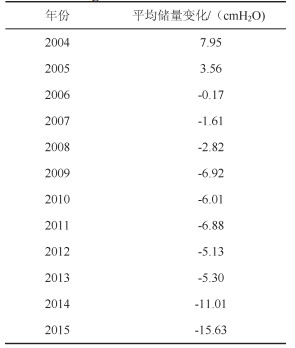
表 2 1975—2010年华北平原主要深层地下水漏斗水位埋深变化
Table 2. Change of water level depths in centers of several major deep groundwater depression cones from 1975 to 2010 in the NCP
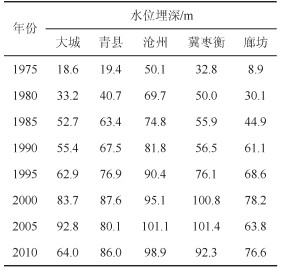
表 3 1961—2010年北京平原平均降水量变化
Table 3. The average annual rainfall from 1961 to 2010 in the Beijing plain
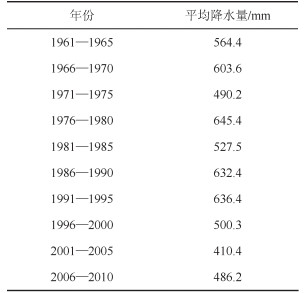
表 4 2004—2013年天津平原各地层的变形量占比(%)
Table 4. Percentage of the deformation for different strata in the Tianjin plain (2004-2013)

表 5 2010—2014年沧州市区第一和第三压缩层地下水位埋深和累计变形
Table 5. The groundwater level depth and deformation of the first and the third compression layers from 2004 to 2013 in the downtown of Cangzhou

表 6 天津平原不同地下水位变化模式下的土层变形特征
Table 6. The deformation characteristics of different soil layers under different change patterns of groundwater levels in the Tianjin plain

-
Bai Jinbin, Niu Xiujun. 2010. Cenozoic consolidation characteristics and land subsidence in Tianjin[J]. The Chinese Journal of Geological Hazard and Control, 21(1):42-46(in Chinese with English abstract). http://en.cnki.com.cn/Article_en/CJFDTOTAL-ZGDH201001011.htm
Craig R F. 2004. Soil mechanics[M], 7th edn. Spon Press, Taylor & Francis Group, London and New York.
Fang Hao, He Qingcheng, Zhao Tingting, Wu Aihua. 2014.Construction of a risk assessment index system for land subsidence in Cangzhou City[J]. Shanghai Land & Resources, 35(2):9-12(in Chinese with English abstract). https://link.springer.com/content/pdf/10.1007/s12665-009-0024-6.pdf
Guo Haipeng, Ding Guoping, Zhu Juyan, Tian Xiaowei, Lei Jiantao, Wang Yunlong. 2014. Compression deformation and permeability characteristics of clay in land subsidence area of Cangzhou[J]. Journal of Wuhan University of Technology, 36(5):111-117(in Chinese with English abstract). http://en.cnki.com.cn/Article_en/CJFDTotal-WHGY201405022.htm
Guo Yonghai, Shen Zhaoli, Zhong Zuoshen, Wang Dongsheng. 1995.The property of deep-lying groundwater resources in Hebei plain and its reasonable evaluation in view of land subsidence[J]. Earth Sciences, 20(4):415-420(in Chinese with English abstract). http://en.cnki.com.cn/Article_en/CJFDTOTAL-DQKX199504011.htm
Guo Haipeng, Zhang Zuochen, Cheng Guoming, Li Wenpeng, Li Tiefeng, Jiao Jiu Jimmy. 2015. Groundwater-derived land subsidence in the North China Plain[J]. Environmental Earth Sciences, 74:1415-1427. doi: 10.1007/s12665-015-4131-2
Hu R L, Yue Z Q, Wang L C, Wang S J. 2004. Review on current status and challenging issues of land subsidence in China[J]. Engineering Geology, 76:65-77. doi: 10.1016/j.enggeo.2004.06.006
Jiang Yuan, Tian Fang, Luo Yong, Wang Rong, Yang Yan. 2015.Research on the relationship between groundwater level and layered subsidence in typical regions of Beijing[J]. South-North Water Transfers and Water Science & Technology, 13(1):95-99 (in Chinese with English abstract). https://www.researchgate.net/publication/283786093_Research_on_critical_groundwater_level_under_the_threshold_value_of_land_subsidence_in_the_typical_region_of_Beijing
Khan A S, Khan S D, Kakar DM. 2013. Land subsidence and declining water resources in Quetta Valley, Pakistan[J]. Environmental Earth Science, 70(6):2719-2727. doi: 10.1007/s12665-013-2328-9
Li Hong, Xiao Guoqiang, Yang Jilong, Zhao Changrong, Xiao Yi. 2016. Precise identification of land-subsiding layers and reconstruction of subsidence process in Tianjin Binhai New Area[J]. Geological Bulletin of China, 35(10):1646-1652(inChinese with English abstract). http://www.researchgate.net/publication/311802311_Precise_identification_of_land-subsiding_layers_and_reconstruction_of_subsidence_process_in_Tianjin_Binhai_New_Area
Motagh M, Walter T R, Sharifi M A, Fielding E, Schenk A, Anderssohn J, Zschau J. 2008.Land subsidence in Iran caused by widespread water reservoir overexploitation[J]. Geophysical Research Letters, 35(16):1029-1039. http://onlinelibrary.wiley.com/doi/10.1029/2008GL033814/full
Niu Xiujun. 1998. Characteristics of Strata Consolidation and Land Subsidence Controlling by Critical Water Level[J]. The Chinese Journal of Geological Hazard and Control, 9(2):68-74 (in Chinese with English abstract). http://www.nsfc.gov.cn/Portals/0/fj/fj20160106_01.xls
Pacheco-martínez J, Hernandez-marín M, Burbey T J et al. 2013.Land subsidence and ground failure associated to groundwater exploitation in the Aguascalientes Valley, México[J]. Engineering Geology, 164:172-186. doi: 10.1016/j.enggeo.2013.06.015
Shelley E O, Ossa A, Romo M P. 2007. The Sinking of Mexico City:Its Effects on Soil Properties and Seismic Response[J]. Soil Dynamics and Earthquake Engineering, 27:333-343. doi: 10.1016/j.soildyn.2006.08.005
Stramondo S, Bozzano F, Marra F et al. 2008. Subsidence induced by urbanisation in the city of Rome detected by advanced InSAR technique and geotechnical investigations[J]. Remote Sensing of Environment, 112:3160-3172. doi: 10.1016/j.rse.2008.03.008
Tomas R, Romero R, Mulas J. 2014. Radar interferometry techniques for the study of ground subsidence phenomena:a review of practical issues through cases in Spain[J]. Environmental Earth Science, 71(1):163-181. doi: 10.1007/s12665-013-2422-z
Wang Fei, Miao Linchang, Lu Weihua. 2013. Sand creep as a factor in land subsidence during groundwater level recovery in the southern Yangtze River delta, China[J]. Bulletin of Engineering Geology and the Environment, 72:273-283. doi: 10.1007/s10064-013-0474-7
Wang Jiabing, Li Ping, Zhang Baiming, Wang Yabin. 2010. Allowable groundwater withdrawal and its determination basis in Tianjin Plain[J]. Earth Science Frontiers, 17(6):221-226 (in Chinese with English abstract). https://www.sciencedirect.com/science/article/pii/S0306261913000196
Wang Rong, Luo Yong, Yang Yan, Zhou Yi, Liu Mingkun. 2014. Land subsidence on the Wenyu River alluvial fans, Beijing[J].Shanghai Land & Resources, 35(4):44-48(in Chinese with English abstract). http://doi.wanfangdata.com.cn/10.3969/j.issn.2095-1329.2014.04.010
Wu Chen, Wang Zihui, Xu Qinghai. 1986. The shallow buried paleochannels in Hebei plain[J]. Acta Geographica Sinica, 41(4):332-340. http://en.cnki.com.cn/Article_en/CJFDTOTAL-DLXB198604004.htm
Xing Zhongxin, Li Hexue, Zhang Shu, Gao Hongqiang. 2004. Surface subsidence and its countermeasures in Cangzhou City[J]. Geological Survey and Research, 27(3):157-163 (in Chinese with English abstract). http://d.wanfangdata.com.cn/Periodical_qhwjyjjz200403005.aspx
Xue Yuqun, Zhang Yun, Ye shujun, Wu Jichun; Li qinfen. 2005. Land subsidence in China[J]. Environmental Geology, 48(6):713-720. doi: 10.1007/s00254-005-0010-6
Xue Yuqun, Zhang Yun, Ye shujun, Wu Jichun; Wei Zixin, Li qinfen, Yu Jun. 2006. Research on the problems of Land subsidence in China[J]. Geological Journal of China Universities, 48(6):713-720 (in Chinese with English abstract). http://d.wanfangdata.com.cn/Periodical_gxdzxb200602001.aspx
Zhang Youquan, Gong Huili, Gu Zhaoqin. 2014. Characterization of land subsidence induced by groundwater withdrawals in the plain of Beijing city, China[J]. Hydrogeology Journal, 22:397-409 doi: 10.1007/s10040-013-1069-x
Zhang agen, Yang Tianliang. 2010. Latest progress review of research on international land subsidence[J]. Shanghai Geology, 31 (4):57-63 (in Chinese with English abstract). http://en.cnki.com.cn/Article_en/CJFDTOTAL-SHAD201004013.htm
Zhang Yun, Xue Yuqun, Wu Jichun, He Jiajia, Wang Huimin. 2011.Experimental study of creep deformation of saturated clay[J]. Rock and Soil Mechanics, 32(3):32(3):672-676(in Chinese with English abstract). http://en.cnki.com.cn/Article_en/CJFDTOTAL-YTLX201103006.htm
Zhang Yun, Xue Yuqun, Wu Jichun, Wang Huimin, He Jiajia. 2012.Mechanical modeling of aquifer sands under long-term groundwater withdrawal[J]. Engineering Geology, 125:74-80. doi: 10.1016/j.enggeo.2011.11.006
Zhou Yi, Luo Yun, Guo Gaoxuan, Luo Yong, Lei Kunchao, Wang Rong. 2016. A study of the characteristics of land subsidence and the main control factors in the alluvial plain:A case study of Beijing plain[J]. Geological Bulletin of China, 35(12):2100-2110(in Chinese with English abstract). http://or.nsfc.gov.cn/bitstream/00001903-5/258424/1/1000014066950.pdf
白晋斌, 牛修俊. 2010.天津新生界固结特征与地面沉降[J].中国地质灾害与防治学报, 21(1):42-46. http://doi.wanfangdata.com.cn/10.3969/j.issn.1003-8035.2010.01.009
郭海朋, 丁国平, 朱菊艳, 田小伟, 雷建涛, 王云龙. 2014.沧州地面沉降区黏土压缩变形和渗透特征研究[J].武汉理工大学学报, 36(5):111-117. http://www.doc88.com/p-2062378232564.html
郭永海, 沈照理.1995.从地面沉降论河北平原深层地下水资源属性及合理评价[J].地球科学, 20(4):415-420. http://www.cqvip.com/QK/94035X/199504/1710787.html
房浩, 何庆成, 赵婷婷, 吴爱华. 2014.沧州市地面沉降风险评价指标体系构建研究[J].上海国土资源, 35(2):9-12. http://www.cqvip.com/QK/97895A/201402/662924942.html
姜媛, 田芳, 罗勇, 王荣, 杨艳. 2015.北京典型地区分层地面沉降与地下水位变化关系[J].南水北调与水利科技, 13(1):95-99. http://www.docin.com/p-1657066702.html
李红, 肖国强, 杨吉龙, 赵长荣, 肖艺. 2016.天津滨海新区地面沉降层位的精准识别[J].地质通报, 35(10):1646-1652. doi: 10.3969/j.issn.1671-2552.2016.10.012
牛修俊. 1998.地层的固结特征与地面沉降临界水位控沉[J].中国地质灾害与防治学报, 9(2):68-74. http://www.cqvip.com/QK/98314X/199802/3006776.html
王家兵, 李平, 张百鸣, 王亚斌. 2010.天津平原地下水可开采量与确定依据[J].地学前缘, 17(6):221-226. http://www.cqvip.com/QK/98600X/201006/36208968.html
王荣, 勇, 杨艳, 周毅, 刘明坤. 2014.北京温榆河冲洪积扇地面沉降特征及机理研究[J].上海国土资源, 35(4):44-48. http://kns.cnki.net/KCMS/detail/detail.aspx?filename=shad201404012&dbname=CJFD&dbcode=CJFQ
吴忱、王子惠、许清海. 1986.河北平原的浅埋古河道[J].地理学报, 1986, 41 (4):332~340. http://www.oalib.com/paper/1561455
邢忠信, 李和学, 张熟, 郜洪强.2004.沧州市地面沉降研究及防治对策[J].地质调查与研究, 27(3):157-163. http://d.wanfangdata.com.cn/Periodical_qhwjyjjz200403005.aspx
薛禹群, 张云, 叶淑君, 吴吉春, 魏子新, 李勤奋, 于军. 2016.我国地面沉降若干问题研究[J].高校地质学报, 12 (2):153-160. http://kns.cnki.net/KCMS/detail/detail.aspx?filename=gxdx200602000&dbname=CJFD&dbcode=CJFQ
周毅, 罗郧, 郭高轩, 罗勇, 雷坤超, 王荣. 2016.冲洪积平原地面沉降特征及主控因素——以北京平原为例[J].地质通报, 35(12):2100-2110. doi: 10.3969/j.issn.1671-2552.2016.12.018
张阿根, 杨天亮. 2010.国际地面沉降研究最新进展综述[J].上海地质31 (4):57-63. http://www.wenkuxiazai.com/doc/0cf3f261ddccda38376bafd7.html
张云, 薛禹群, 吴吉春, 何佳佳, 王惠敏. 2011.饱和黏性土蠕变变形试验研究[J].岩土力学, 32(3):672-676. http://kns.cnki.net/KCMS/detail/detail.aspx?filename=ytlx201103006&dbname=CJFD&dbcode=CJFQ
-



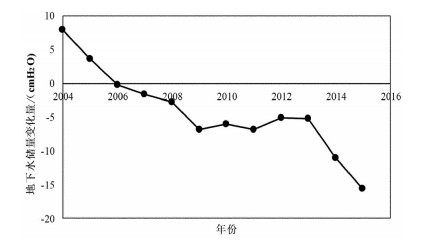
 下载:
下载:
